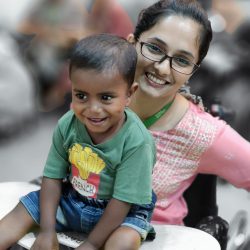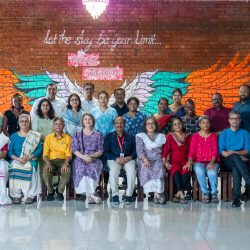October 2012
Dear Friends,
One of our team members, Dr Nidha (she is getting married; join us in wishing the couple well; we are very sad that she is leaving town, though) said that the hardest lesson in palliative care to learn was the one about being non-judgmental.
“I am trying hard”, she said in a moment of introspection. “but it is not easy”.

We thought it important to open this newsletter with Dr Nidha’s thought as we see its importance more and more. As the palliative care movement grows in the country, the movement itself gets powerful and sometimes, even aggressive.
Power is always notorious for being corruptible; and here the victim could well be the patient – because he is stripped of all power, physical, emotional, spiritual, and is at the mercy of the system.
Till the palliative care worker has learned to avoid being judgmental, his basic palliative care education is not complete. It is easy to get self-righteous and to label patients and family members as good or bad.
If we do, it shows in our actions, body language and facial expressions, and actually worsens the patients’ suffering.
–
World Palliative Care Day 2012: The Sea and the Sand on the Feet
Don’t you love the beach? Don’t you like the feel of the sand on your feet as the sea washes over them?
Most of us do, and also perhaps, take if for granted. There are a few among us for whom this is not an every day affair, but a dream.
 About 40 of our patients, many of them wheelchair-bound, met together on 13th October 2012 at Shanghumugham beach to celebrate World Palliative Care Day.
About 40 of our patients, many of them wheelchair-bound, met together on 13th October 2012 at Shanghumugham beach to celebrate World Palliative Care Day.
The National Rural Health Mission and District Panchayath had joined hands with Pallium India to make it possible.
Many of the attendees may never have had a chance to see the sea again in their lifetimes. They had fun!
–
Watch a Movie and Help Our Patients!

Mr Gireesh Chandran and his father Shri Chandran, who own Sree Padmanabha Theater in Trivandrum decided to do something to commemorate the sacred memory of theater founder, the late Shri P Subramaniam.
 1% of the collection in the movie house now come to Pallium India for the support of our poor patients.
1% of the collection in the movie house now come to Pallium India for the support of our poor patients.
On World Palliative Care Day during get-together of patients at Shanghummugham, Her Highness Shri. Aswathy Thirunal Maharani precedes a cheque from Mr.Gireesh Chandran on behalf of Pallium India.
Thank you Mr Gireesh Chandran. You not only help our patients but also make every movie goer blessed.
–
Moving Forward: Palliative Care in Government’s Health Care System
 Centre for Innovations in Public Systems (CIPS) in Bangalore included Palliative Care in their agenda for discussion in their two day workshop on “Best Practices in Health Sector” and Dr Shoba Nair delivered a talk.
Centre for Innovations in Public Systems (CIPS) in Bangalore included Palliative Care in their agenda for discussion in their two day workshop on “Best Practices in Health Sector” and Dr Shoba Nair delivered a talk.
Dr Chakrapani, director of CIPS said palliative care would be included in the Maternal and Child Health program for next year.
We are moving forward step by step. Thank you CIPS and Dr Chakrapani.
–
Breast Health Gobal Summit and Cancer Survivors
Touching stories of cancer survivors stole every heart at the Breast Health Global Summit at Vienna on 3-5 October 2012.
The thoughtful organizers had arranged to have one talk by a cancer survivor on each day of the conference.

Ms Gertrude Nakigudde’s experiences were an example. She survived cancer, but later when her father-in-law got cancer, he blamed her for “bringing cancer to the family”.
The cancer survivors’ stories about the insensitivity of medical professionals made everyone think.
The summit analyzed quality of life issues associated with breast cancer in low and middle income countries from the perspectives of “survivor-ship and follow up care, treatment related supportive care and end-of-life and palliative care”.
Dr Sudhir Gupta, Additional Director General of Health Services of Government of India – whom Dr Jim Cleary described as an official in charge of the health of 17% of the world’s population – put palliative care into perspective of India’s health care system and talked about the Government of India’s plans to integrate palliative care into health care as a whole.
Dr Jim Cleary
–
Pallium India’s “man” on the beach at San Diego
 Ever noticed the figure of the man on Pallium India’s logo? He forms the “A” following the first letter P, protected on both sides by a hand each.
Ever noticed the figure of the man on Pallium India’s logo? He forms the “A” following the first letter P, protected on both sides by a hand each.
A group of people from several countries joined hands to re-create him on the beautiful beach at San Diego, California. It was fun; but fun while learning. As four teams worked independently to make sand castles, they learnt how to work with strengths and weaknesses of other team members.

This is the second cohort of “leaders” selected from the palliative care field all over the world to undergo a two year program which includes three 7 day contact sessions in San Diego.
This time the 20-strong group included four Indian leaders, Dr Anjum Joad from Jaipur, Dr Chitra Venkateswaran from Kochi, Dr Dinesh Goswami from Guahati and Dr Shoba Nair from Bangalore, with Pallium India’s chairman as one of the mentors. The group also included two of India’s next door neighbours, Dr Bishnu Paudel from Nepal and Dr Rumana Dawla from Bangladesh.
The imaginative program is conducted under the leadership of Dr Frank Ferris, Director of San Diego Institute of Palliative Medicine, ably supported by a team including Dr Shannon Moore, Dr Eileen Piersa, Stephanie Whitmore, Debra Pledger-Fonte and many others.
Ms Mary Callaway of Open Society Foundation and Ms Katherine Pettus of Pettus Foundation represented the founders.
Kudos to the LDI team!
–
ehospice Opens with News of Rahul Dravid Batting for Palliative Care
ehospice is now open! Established by the Worldwide Palliative Care Alliance as a news and information sharing website for people working in hospice, palliative, and end of life care.
The India edition of ehospice is edited by Ms Nisha Krishnadas, the national information officer of the Indian Association of Palliative Care. Nisha gives us exciting news about the Indian cricket icon Rahul Dravid‘s support to Palliative Care,
Rahul Dravid bats for Karunashraya; Pledges his support to Palliative Care
The gesture from Dravid is not a surprise. He has been a good ambassador for the country and the sport. Now, after retirement, he’s setting the bar even higher for everyone to follow.
Rahul Dravid, the international cricketer and former Indian captain has pledged his support to Bangalore Hospice Trust as a ‘Friend of Karunashraya Hospice’ to help suffering patients. The cricketing legend has presented a number of pieces of highly-prized personal memorabilia, including a signed bat and his India jersey to Karunashraya to help raise funds.
These valuables will be put up for auction on World Hospice and Palliative Care Day, 13th October 2012. All funds collected from the auction will be directed towards the operational requirements and costs of Karunashraya, the “abode of compassion”, which provides hospice and palliative care for suffering patients since 1994.
Read more at ehospice…
–
More Media Attention on India’s Shameful Failure in Access to Pain Relief

“India is the world’s largest producer of opium from which cancer & HIV pain reliever morphine in made, yet patients struggle to get access to drug because of legal and bureaucratic issues”, the article says, and goes on to describe the current efforts to improve the situation – read the full article here…
But while we, in our arrogance of health, are patiently waiting for things to change, how many lives continue to go through all-encompassing, needless pain?
Let us hang our heads in shame.
–
Could a Black Mamba Be What We Have Been Waiting for?
Currently, opioids form the mainstay of pain management, at least in cancer pain and in post-operative pain. True, opioids are safer than most other currently available analgesics, but still the side effects are a nuisance.
May be tomorrow, snake venom may offer us a powerful and safe pain killer, the BBC reports:
Black mamba venom is ‘better painkiller’ than morphine”
A painkiller as powerful as morphine, but without most of the side-effects, has been found in the deadly venom of the black mamba, say French scientists.
The predator, which uses neurotoxins to paralyse and kill small animals, is one of the fastest and most dangerous snakes in Africa.
However, tests on mice, reported in the journal Nature, showed its venom also contained a potent painkiller.
They admit to being completely baffled about why the mamba would produce it.
The researchers looked at venom from 50 species before they found the black mamba’s pain-killing proteins – called mambalgins.
Long way to go yet, though. It is early days still, as far as research on the subject is concerned.
–
What is Goddess Kali Doing in a Hospice?
 Dr David Brumley is a great friend of the palliative care scene in India. He has been giving us so much!
Dr David Brumley is a great friend of the palliative care scene in India. He has been giving us so much!
As part of our Hamrahi program, David Brumley and friends visited the palliative care program at the Cachar Cancer Hospital in Silchar, Assam. Hamrahi, headed by Dr Odette Spruyt, is a program that matches Australian palliative care consultants with palliative care centers in India, so that there are annual visits for support.
Dr Ravi Kannan who directs the center, his wife Sita and Dr Iqbal Bahar have been running the palliative care program which Dr David Brumley describes in his article, “An Island of Compassion” in the Journal of Pain and Palliative Care Pharmacotherapy (September 2012, Vol. 26, No. 3 , Pages 271-273).
As Dr Brumley describes his visit to the center, he says,
To one side a figure of the goddess Kali sits in a small building—a site of her own. Her black face, protruding tongue, and garland of blood-red flowers are disturbing. The black face makes me shiver.
What is she doing here?
An interesting question. He goes on to say,
I wonder how a sick devotee of another religion might react to seeing a crucifix on the wall of their hospital room.
Wise words, indeed, Dr Brumley. To the believer, Goddess Kali wards off evil spirits and protect the patients, just as the crucifix gives a Christian peace of mind.
But what about those who do not share that faith?
–
A Life Lived with Dignity
 An article on livemint.com points out the relevance of palliative care in health care and particularly highlights its importance for the family members of the patient, who often suffer as much as the patient, and continue to suffer even when the patient is gone.
An article on livemint.com points out the relevance of palliative care in health care and particularly highlights its importance for the family members of the patient, who often suffer as much as the patient, and continue to suffer even when the patient is gone.
It highlights the point that palliative care is not just for the last few days of life. It quotes Dr M.M Sunil Kumar, Deputy Director of Trivandrum Institute of Palliative Sciences,
… regardless of the type of disease, or how advanced it may be, there is always something that can be done to improve the quality of life of the patient.
To read the full article by Sujata Kelkar Shetty here: A Life Lived with Dignity
–
PARTING SHOT

Pallium India’s volunteer Ms Sunshine Mugrabi sends us the heartrending story of a man who seems to wish he could choose a gentler death, but has decided to hang on so that he can be legally married before he dies:
Bill Nemitz: In the end, that marriage certificate means a lot
We may not know how you react to this touching story.
Some may think more about the issue of gay marriages or of the legal system. Some would be judgmental, some forgiving (there is not all that much of a difference, perhaps) and some, understanding. Some may latch on to the issue of advance directives and some may start wondering how to get the man to a state of acceptance of “reality”.
We just shed a tear for all those who die without fulfilling a last and overpowering desire for something – to see a loved one again, to have one last meal at home with the family or just to die in one’s own bed at home – just because they are physically helpless because of a disease and because the medical system has taken over their lives and chosen to imprison them in intensive care units.
–








